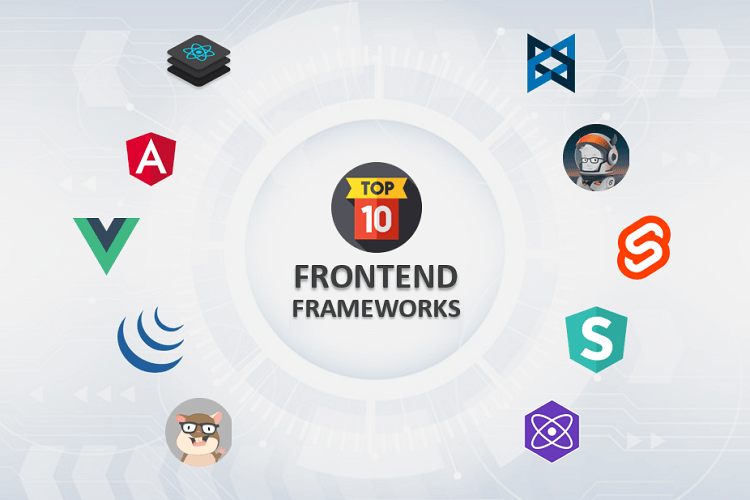Frontend frameworks are the building elements of the software. However, there are many choices for creating aesthetically pleasing applications that rate well on user experience. We have compiled a list of the best frontend frameworks expected to be available to assist you. Allow me to look into them.
Every company in today’s market emphasizes providing the best possible user experience. A developer’s brief for a project often stresses creating a straightforward user interface.
Whatever happens behind the scenes regarding sophisticated activities and procedures for frontend technologies, the front-facing experience for users must be flawless. Successful businesses like Netflix, Facebook, Instagram, etc., function on this idea.
What is a Frontend Framework?
The frontend of a website or web application is everything the user sees when they visit or use the app. This includes the design, graphics, navigation, typography, placement of pieces, and more.
A frontend framework is a toolkit that facilitates using pre-built components in creating user-facing software. A frontend framework is akin to a set of blueprints or blueprints upon which the user interface of an application may be built.
You may avoid writing custom code for every part of the user interface (UI) without sacrificing any functionality by using a front-end framework.
List of Best Frontend Frameworks

According to the results of the State of JavaScript survey, React (64%), Svelte (62%), and Vue.js (53%) are the frontend frameworks with the highest approval ratings.
57% of developers expect to use React again, with Vue.js at 30% and Angular at 17% following closely after. Solid (46%), Qwik (46%), and Svelte (45%) are, nevertheless, the top three frameworks that developers want to master in the future.
But numerous frameworks still need to pique the attention of the programming world. In this group, Ember (63%) is far and away the favourite, followed by Alpine.js (44%) and Preact (43%).
Let’s examine the best frontend frameworks in-depth and weigh their advantages and disadvantages.
React, Angular, Amber, Vue.js, Svelte, jQuery, Backbone, and Semantic UI will be the best frontend frameworks, thus it’s important to weigh their benefits and downsides.
1. React
Among the most straightforward frameworks to pick up is React, created at Facebook to address problems with code maintainability brought on by the app’s rapid expansion.
React, currently available as open source, differentiates from other frameworks because of the remarkable capabilities made possible by implementing a virtual Document Object Model (DOM). This framework is excellent for sites that expect a lot of visitors and require a solid foundation to support them.
When consulting on technology projects, I suggest using React for developing PWAs and other single-page web apps.
Pros:
- Their reusability facilitates cooperation and reuse of components in various program areas.
- With virtual DOM, performance is consistent and uninterrupted.
- Components can be written without using classes, making it easier to understand React and the ideal alternative to using React hooks.
- The development tools for React are cutting-edge and helpful.
Cons:
- There is a steep learning curve for newcomers because of the frequent and extensive framework changes, making it difficult to provide comprehensive documentation.
- When first starting with the JSX framework, developers often need help to make sense of the syntax’s many subtleties.
- This tool mainly provides superficial fixes.
2. Angular
Angular must be included when compiling a list of the top frameworks for developing website front ends. Only one framework here, Angular, uses TypeScript as its Foundation. Google created Angular in 2016 to close the gap between the ever-increasing expectations placed on technology and the tried-and-true methods that have historically yielded positive outcomes.
Two way data binding of Angular is a standout feature that can’t be found in React. This implies that any changes made to the model are reflected quickly in the View and vice versa and that the two perfectly sync in real time.
Angular is an excellent choice if you need to create a web or mobile app. This framework is also helpful in creating progressive web apps and multi-page web applications. Angular creates apps deployed by companies like BMW, Xbox, Forbes, Blender, and others.
The learning curve for Angular is steep compared to that of React. Despite the abundance of written materials, most need to be more concise to understand or more specific to be helpful to the average reader.
Pros:
- The model may automatically refresh the View, and the display can reflect the model’s changes.
- helps keep code sizes down by including commonly used features like two-way data binding out of the box
- separates the components from their reliance on one another by labelling the latter as “external elements.”
- Dependency injection makes it simple to reuse and manage components.
- A large group of people to learn from and get support from
Cons:
- The learning curve is higher for Angular since it is a comprehensive dynamic solution; hence, various approaches exist to achieve the work. However, Angular’s extensive online community makes it simple for newcomers to grasp the language’s fundamentals and use its technologies quickly.
- Due to their intricate design and large size, dynamic applications sometimes need help to provide a smooth user experience. On the other hand, Angular’s code optimization and best practices.
3. Vuejs
Vue is an essential and uncomplicated framework that has become one of the most popular frontend options today. It does a great job of simplifying the challenges that Angular developers confront. It has a reduced footprint and two primary benefits: visible DOM and component-based. Furthermore, this connection works in both directions.
Vue’s adaptability makes it useful for a wide range of situations. It can handle static and dynamic operations, making it ideal for creating online, mobile, and advanced web applications.
Despite its ability to enhance app speed and handle complexity, it has yet to find widespread adoption among industry leaders. On the other hand, companies like Alibaba, 9gag, Reuters, and Xiaomi have adopted this structure. Despite seeing fewer adopters in Silicon Valley, Vue’s adoption rate is rising.
Pros:
- Comprehensive and in-depth records
- Vuejs has a straightforward syntax, making it accessible to developers coming from a JavaScript background.
- Freedom in laying up the framework of the app
- Help for Typescript
Cons:
- Instability of individual parts
- The community size is modest.
- Most plugins are written in Chinese, creating a linguistic barrier.
4. jQuery
The jQuery frontend framework was first released in 2006, making it an old-timer in the industry. What sets it apart is not its release date but rather its continued relevance in the modern technological landscape. jQuery not only provides simplicity and convenience of use and reduces the need to create complex JavaScript programs.
jQuery has been around for a while. Therefore, there is a sizable community working on solutions. jQuery is a toolkit that may improve a website’s functionality and interaction by manipulating CSS and DOM.
Until recently, we could not use jQuery to create mobile applications; now, with the release of jQuery Mobile, the framework’s potential has been unlocked. Additionally, the latest enhancements to this framework make it possible for programmers to create native mobile apps through its HTML5-based UI system, jQuery Mobile. In addition, jQuery works with whatever browser you could use.
Pros:
- Element addition and deletion are both possible in DOM.
- Easy HTTP requests sending.
- helps make dynamic content possible
- Reduced complexity of HTTP requests
Cons:
- The low productivity in comparison
- Many sophisticated solutions are available other than jQuery.
- It is no longer possible to use the Document Object Model’s APIs.
5. Emberjs
While both Angular and Emberjs are component-based frameworks with two-way data binding, Emberjs was developed in 2011. It was built to accommodate the complex needs of today’s technology without a hitch. Emberjs’s well-designed architecture will address problems even in the most sophisticated mobile and online apps you create.
However, Ember has a steep learning curve, which is one of its few drawbacks. Because of its strict and traditional form, the framework is one of the most difficult to master. Because it is so fresh and uncharted, a small population of developers is working in this area. Anyone who can devote time to education should give it a go.
Pros:
- Well-organized
- most rapid architecture
- In-and-out data fusion
- Accurate record-keeping
Cons:
- A tiny, less-populated community.
- Intricate syntax and sluggish revisions
- Slow and painful progress
- Heavier-than-needed infrastructure for minor programs
6. Backbonejs
Backbone is one of the most straightforward frameworks for creating single-page apps. This framework uses a Model-View-Controller design pattern. It is possible to put component logic in the View of an MVC application like that of a Controller.
Additionally, this framework is compatible with engines like underscore.js and Moustache. You can get the most out of the Backbone framework with the help of additional tools like Thorax, Marionette, Chaplin, Handlebars, and many more.
The platform also lets you create projects that call for unique users by providing arrays that can be used to categorize models. Therefore, whether you plan to use Backbonejs for the front or back end, this is a great option because of the excellent interoperability with REST APIs.
Pros:
- Considered to be a lightning-fast javascript framework
- Quick to pick up
- Super light construction
Cons:
- It gives you the fundamentals you need to build your app’s Foundation (but not a premade one)
- We need to develop repetitive code for connecting views to models and models to ideas.
7. Semantic-UI
Despite being a relative newbie to the frameworks scene, Semantic-UI is rapidly gaining traction and poised to become one of the world’s most widely used frontend frameworks.
What sets it apart is the simplicity and ease with which it performs its functions and is used by its users. It uses everyday language, which makes the codes easy to understand.
This makes the framework accessible to novice programmers eager to get started. In addition, it integrates with many third-party libraries, making the development process much more efficient.
Pros:
- Recent frontend frameworks include
- Features usable “right out of the box.”
- Easily simplified
- Full-featured user interface with quick responses
Cons:
- Larger quantities
- Not for those who know no javascript at all.
- Need the skills to create unique specifications.
8. Foundation
We have seen a few frontend frameworks that are simple enough for novices to use. However, this is different with Foundation. Designed by Zurb, it is optimized for building highly functional, flexible websites at the corporate level. The Foundation application development framework is complex and challenging to use for beginners.
In addition to providing GPU acceleration for silky-smooth animations and fast mobile rendering, it also has data-exchange capabilities, such as the ability to load light chunks for mobile and hefty sections for more giant screens.
The best way to learn the Foundation and get comfortable with its intricacies is to dive headfirst into independent projects. In addition to Mozilla, eBay, and Microsoft, many more companies use it.
Pros:
- Swappable grids
- Allows you to design stunning websites
- Library for validating HTML5 forms
- Device and medium-specific customization of the user experience
Cons:
- Extremely difficult for newcomers to pick up
- Lessening of online support groups and discussion forums
- Twitter’s Bootstrap, a competitor framework, is more widely used than Foundation.
9. Svelte
Svelte is the most up-to-date frontend framework available. In contrast to other popular frameworks like React and Vue, this one distinguishes by moving development tasks away from the browser and into a compilation phase. It generates the necessary code to keep the DOMO in sync with the running app.
Pros:
- Quicker response time
- lightning-fast compared to competing frameworks like Angular and React
- Recent only
- Adaptable architecture
- Minimal in size and complexity while making use of preexisting JavaScript libraries
Cons:
- Regional hub
- Insufficient backing
- Poor equipment
- It has yet to gain widespread acceptance.
10. Preact
Preact is a JavaScript framework that may be used as a faster, more lightweight substitute for the popular React. It’s tiny (just 3kB when gzipped) compared to React (45kB), yet it has all the same features and API. Because of its small footprint and ability to display the quickest Virtual DOM library, it is often used to create software applications.
Preact is compatible with React and has a comparable interface, saving developers the trouble of learning another framework. In addition, developers may alias their way into using any React packages and components, even the most sophisticated ones, thanks to preact-compat’s ultra-thin compatibility layer.
Therefore, Preact may save you time whether you’re just getting started or are farther along in developing an established project. Preact is an option if you like working with React to construct views but also value speed and efficiency. Various websites, including IKEA, Bing, Uber, Etsy, and many more, use Preact.
Pros:
- Reduces the code in your bundle libraries to make loading times faster.
- Allows highly dynamic applications and pages to load in under 5 seconds with a single RTT; perfect for progressive web apps
- Its portability and embeddability make it viable for developing standalone app components.
- A robust, single-purpose CLI that speeds up the inception of new projects.
- Compatibility with other React libraries is excellent.
Cons:
- Contrary to Facebook’s maintenance of React, supported by a prominent tech business, this project has a small community behind it.
- Preact doesn’t have synthetic event handling like React, which might lead to impedance mismatch problems in performance and maintenance if you use React in development and Preact in production.
Conclusion
After working on everything from massive infrastructure projects to minimum viable products, I’ve narrowed my list of preferred frontend frameworks to the following. Nonetheless, you now have a good notion of which framework to use based on the specifics of your project and you may hire a dedicated developer for best results.
Many different frontend frameworks are available, which might make it challenging to choose one. It is more complicated to learn about them, amass the necessary expertise, and choose the best one.
The most excellent aspect is that practically all frameworks are relatively easy to pick up, even at a basic level. The best way to decide on a frontend framework is to consult your most experienced frontend engineer.


